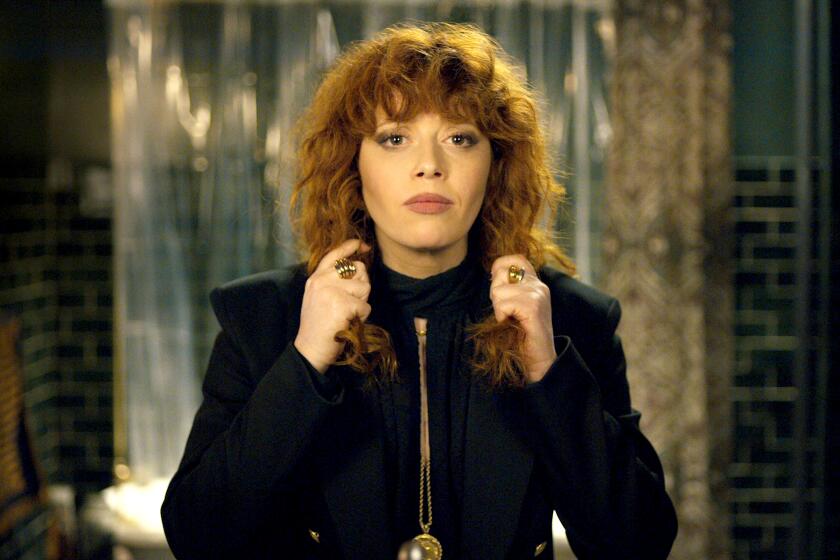‘Yummy mummies with predatory husbands’ took over TV. Blame David E. Kelley

The following contains major spoilers from Netflix’s “Anatomy of a Scandal.”
In “Anatomy of a Scandal,” premiering Friday on Netflix, writer David E. Kelley — and his viewers — return to familiar terrain: the case of a handsome, wealthy man (Rupert Friend), his beautiful blond wife (Sienna Miller), his beautiful brown-haired mistress (Naomi Scott) and the dogged investigator who hopes to unravel their story (Michelle Dockery). Co-created and co-written with Melissa James Gibson, and directed by S.J. Clarkson, the six-episode series hits all the marks you might expect. There will be twists! There will be tropes! There will be multiple timelines!
But the real question is: Does “Anatomy of a Scandal” work as a guilty-pleasure potboiler or is it yet further evidence that Kelley’s trash-TV rampage must be stopped? Television editor Matt Brennan and staff writer Meredith Blake hash it out:
We surveyed The Times TV team to come up with a list of the 75 best TV shows you can watch on Netflix. As in, tonight.
Matt Brennan: Honestly, the first episode of “Anatomy of a Scandal” wasn’t terrible. And then the second episode happened.
Much of the hour — much of the series — is set in the courtroom where Conservative MP James Whitehouse (Friend) is on trial for the rape of Olivia Lytton (Scott), the former parliamentary colleague with whom he was having an extramarital affair. That is, except for the supremely ham-handed soft-focus flashbacks to which the episode cuts seemingly every other line of Olivia’s testimony, a stylistic tic that took me out of the story rather than rendering it more immediate. And made me want to take a hammer to my TV screen.
Which I suppose is what inspired this conversation. Because even as I found myself exasperated with the series early and often, I devoured “Anatomy of a Scandal” anyway. Then I remembered I’ve had this feeling before, watching other glossy David E. Kelley limited series like HBO’s “The Undoing” and Hulu’s “Nine Perfect Strangers.” Since launching “Big Little Lies” in 2017, he’s turned what you’ve described as the “rich white woman” drama into something of a cottage industry, and these projects feel increasingly paint-by-numbers. Yet I am still drawn to them, episode after episode, almost exactly five years after “Big Little Lies” took television by storm.
I feel like I need to get my therapist involved here, but in the meantime, I’ll ask you: Do you feel the same? And if so, what’s the attraction?

Meredith Blake: I am not sure when or why Kelley decided he would become TV’s foremost chronicler of super-wealthy yummy mummies with predatory husbands, but he sure has embraced this subgenre with glee. Alas, each successive iteration of this formula seems to yield less impressive results.
Based on a novel by Sarah Vaughan, a former political correspondent for the Guardian, “Anatomy of a Scandal” explores a potentially fascinating milieu — the British ruling class — and Friend’s entitled Oxford toff-turned-Tory MP is clearly modeled on the Boris Johnsons and David Camerons of the world. (It should not be confused with Prime Video’s “A Very British Scandal,” another star-studded limited series about sex, power and badly behaved toffs also out this month.)
Despite this sociologically rich terrain, “Anatomy” offers none of the sharp sociological insights of “Big Little Lies.” It doesn’t have much to say about class, sexual consent, political power or the way these forces intersect, and it only seems interested in rape survivors inasmuch as they service the plot through extreme, unethical attempts at revenge. The direction was cheesy and on the nose, especially the device Clarkson uses at the end of each episode to literally depict each character’s emotional state.
And unlike “The Undoing,” it has neither a maliciously charming Hugh Grant nor Nicole Kidman in a collection of extravagant outerwear to keep us invested. It doesn’t even offer much in the way of real estate porn, something we have come to expect of Kelley’s recent productions — or at least the ones with the HBO budgets. (I did like the Whitehouses’ kitchen wallpaper, though.)
Even with these obvious shortcomings, I couldn’t seem to pry myself away from “Anatomy of a Scandal.” Maybe it was the spectacle of “Downton Abbey’s” Lady Mary, Michelle Dockery, in one of those ludicrous barrister wigs. Maybe it was the mercifully brisk pacing — each episode clocks in at 45 minutes. Or maybe I just wanted to see if my prediction about the show’s Big Twist was right (it was), but I found the series shockingly easy to consume even though (or perhaps because) it was so schlocky.
All of which is to say, yes, Kelley (and Gibson) certainly know how to keep us hooked. Should we really be surprised or concerned by this, though? Of course we are going to want to watch a show about sex and scandal involving beautiful, amoral rich people. It’s what makes the world go ’round, right? We used to have lots of R-rated movies and prime-time soaps just like this; now we have star-studded limited series. I guess my point is: This is not a show we need to overthink or feel guilty for watching.
Now, should we talk about the ending? What does it say that spurned wife Sophie (Miller) ultimately becomes the hero of this story by alerting the press to her husband’s involvement in that Lib?
Since “Big Little Lies,” the Oscar winner has brought prestige to a medium eager for it — and inspired a wave of stories about affluent women on the verge.
Brennan: To answer that question I’m going to violate one of the tenets of good criticism and tell you what I wish “Anatomy of a Scandal” had done instead of breaking down what it does do.
First things first, let’s sum up what actually happens: In the course of the series, we learn that James Whitehouse raped Dockery’s prosecutor Kate Woodcroft, then known as Holly Berry, when they were classmates at Oxford. James admits to his wife that the pair had impromptu sex during a run-in on campus but claims it was consensual. Sophie — having also learned that James lied to protect the now-prime minister’s involvement in the accidental, drug-related death of a classmate on the same night as his encounter with Holly — believes Kate in the end. And so, to make amends after Kate loses at trial, Sophie leaks the story of James’ cover-up to the press. It’s implied that Kate will have another crack at revenge, while Sophie moves to an idyllic cottage overlooking the white cliffs of Dover with her two kids. (God, writing it down like this really underscores the ridiculousness level, huh?)
What strikes me about the series’ ending is that two women teaming up to take down the prominent man who wronged them both is in fact a much more compelling storyline than the inert he said/she said courtroom drama we actually get in “Anatomy of a Scandal.” (I mean, the trial consists entirely of Olivia‘s and James’ conflicting testimonies, and their being questioned/berated by the lawyers. It’s mind-bogglingly dull.) This is especially true knowing that Dockery, as the no-bull, out-for-blood barrister, delivers the most exciting performance in the ensemble and that Miller, who spends much of the series as a blank slate, comes alive in the closing episodes as she begins to doubt her husband. But instead we get this completely unearned spouse ex machina to make sure we don’t feel bad that the rapist got away with it.
I will say, though, that laying out the dreadfulness of “Anatomy of a Scandal” point by point as we have in this conversation crystallizes its appeal for me. You say, aptly, that the series and its ilk remind you of mid-budget movies and prime-time soaps from an earlier era; to that list I would add the B-level genre movies of classic Hollywood. What we are looking for in the average genre text isn’t innovation, but exactly what the series gives us: familiar archetypes, paint-by-numbers plot elements, recognizable beats, the ability to watch long stretches while doing emails. In a way, it’s reassuring because it has no ambition or interest beyond getting us from point to point.
Kelley is basically the Roger Corman of the faux-prestige limited series at this point. He works fast, he follows a template, and he can reliably be counted on to keep me engaged for six to eight episodes. (No more!) I will happily sign up for one of those a year for the foreseeable future. Not everything needs to be a masterpiece.

Blake: It sure doesn’t! I suppose what’s frustrating about “Anatomy of a Scandal” is that it has the potential to be, if not a masterpiece, then something much better than it is. As you say, Dockery is particularly good (she even pulls off the wig), and Miller, saddled with the thankless task of providing endless reaction shots in those tedious courtroom sequences, becomes more compelling as her character realizes she’s married to a sociopath.
If only the direction weren’t so corny (that sequence in Episode 5 where Kate and James stood nose to nose in a darkened courtroom, talking about consent, was so stagey I screamed), or the writing so focused on endless witness interrogations (Kelley is the master of the legal drama, but he uses courtroom sequences like a crutch), we might have had something special.
In any case, Kelley shows no signs of slowing down: Later this year we’ll get “Love and Death” on HBO Max, starring Elizabeth Olsen as Candy Montgomery, the cheating Texas housewife who killed her lover’s wife with an ax. Another unhappily married woman, only this time she’s the violent psychopath, not her husband. Quite a change of pace!
More to Read
The complete guide to home viewing
Get Screen Gab for everything about the TV shows and streaming movies everyone’s talking about.
You may occasionally receive promotional content from the Los Angeles Times.









